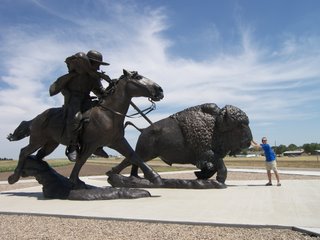July 29, 2006
 July 29, 2006
July 29, 2006This morning we rise early to get a head start on a long driving day. We are going to head east across a very wide Kansas and we are not expecting to stop and see much, plus the forecast is for 100° F temperatures. Colorado is bigger than we think and it is over an hour before we hit Kansas. Right across the border, we stop at the Visitor Center to pick up a better Kansas map. We ask the attendant on duty what there is to see and she gives us a rundown of the attractions at each major exit along I70. Some of them sound interesting so we may not get as far as we hoped today.
Back in the RV, we soon hit the central time zone and we lose an hour. Oooh! forgot about that time change; so much for getting up early. We decide to make our first stop in the town of Oakley. Oakley is where Buffalo Bill (Cody) got his name and first became famous. As the legend goes, he was one of two “Bills” paid by the railroad to hunt buffalo to feed the construction crew. To decide the best Buffalo Bill, the town arranged a shooting contest and Cody won. They have erected a twice-lifesize statue of Cody shooting a buffalo to commemorate their favorite son.
Also in town is something called the Fick Fossil Museum. I am not expecting much; we are mainly using this stop as a break from driving to stretch our legs. The museum is small and connected to the town library. I am pleasantly surprised. Typical of museums out west, they all seem to be an eclectic combination of dino fossils, pioneer history and old town memorabilia. There is something of interest for both Aimee and I. Aimee likes to read about human interest stories, such as the pioneer family that gets attacked by Indians, the parents scalped, and the daughters abducted and later rescued. I like dinosaurs and it seems there are fossils being collected everywhere in the west. Each location is a little different. In ancient times, this part of Kansas was a shallow ocean, so they have found sea serpents in the limestone outcroppings here. In particular, swimming reptiles (Plesiosaurs and Mosasaurs) and fish-eating flying Pterodactyls. I would like to head the twenty miles south to see the “Monument rock” limestone cliffs that stick out of the prairie, and where they found these fossils. Aimee vetoes it once we learn that gravel roads are involved. The RV doesn’t respond well to gravel.
We are hungry so we stop at a greasy spoon called the ‘Dairy King’. After lunch, we order ice cream ‘to go’ but it is melted by the time we hit the highway. Back on the road, we continue east. We see an advertisement for the world’s largest ball of yarn; Aimee wants to go but I veto this one since it is way off the highway. After another hour of driving we stop at Fort Hays State Historic Site to see the original cavalry fort. This is one of many forts in the west that were erected by the army to protect the railroad and settlers from native Indians. Contrary to Hollywood, most of the western prairie forts were constructed of stone because trees were hard to find. The tour is interesting but the 100° heat and fierce wind is draining. I would not have survived either as a cavalryman or Indian.
Also in town is the Sternberg Museum on the campus of Fort Hays State University. In the Fick Museum, I had learned that Sternberg was a famous local fossil hunter, so I assume this will be about his collection. This museum turns out to be more upscale than I would have expected for a small town. The museum is indeed built on Sternberg’s fossil collection but is much more. For example, there is one area with large animatronic dinosaurs roaring and moving. I thought I was in the movie ‘Jurassic Park’. Besides the fossil exhibits, the museum also has a big section on elephants and their mammoth ancestors. It is a first-rate museum I would expect to see in Chicago, not Kansas.
On this month-long cruise of the West, I have seen many more fossil exhibits than I ever expected. I had no idea fossils have been found in so many places in the US. (Chicago is even a fossil hot bed with the Mazon Creek Formation.) The one big advantage to seeing a lot of these collections in a short period of time is that I am starting to understand terms like Jurassic and Cretaceous and I am making connections between what I see in one area with what I see in another. Scary!
By the time we get out of the Fort Hays area, it is after 6:30 pm, so we stop at the next campground east in Russell, KS. Russell is the home of Bob Dole and Arlen Specter. Right next door to the campground, is a small mostly outdoor “Oil Museum”. (Apparently this part of Kansas is oil country.) In between dinner courses, I walk over to the museum without Aimee to check the hours. It is only open 4-8pm so I look around for a half hour. It is a nice break from dinosaurs.



0 Comments:
Post a Comment
<< Home